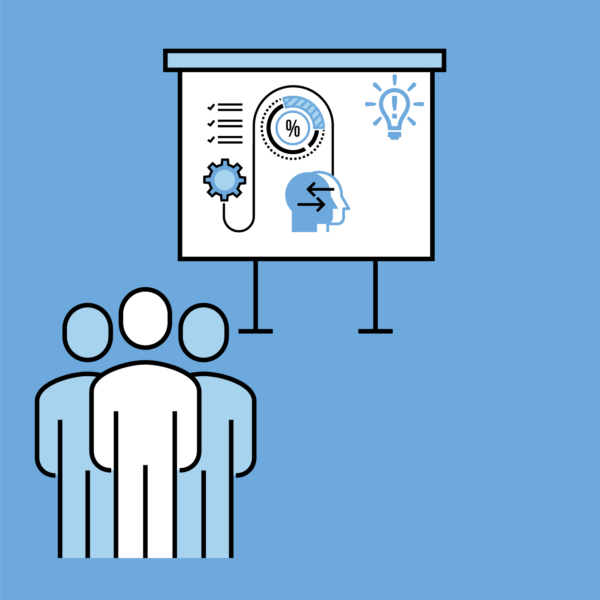Why Have a Brainstorm Meeting

More choices often leads to better decisions. A brainstorming meeting allows the group to leverage various points of view to create more options and then build on the options that have the most appeal to create breakthroughs.
Breakthroughs are creative, “doable” outcomes.
Call to action: Create an environment that allows the group to generate lots of ideas and build on viable outcomes.
- Have one conversation at a time. Allow ideas to be heard and built upon.
- Group participation in the development of a “breakthrough” creates more buy-in for the execution of the outcome.
- Defer judgment. There are no bad ideas at this point. There will be plenty of time to judge ideas later.
- Don’t stray from the topic. When someone gets carried away with the wild and crazy, the facilitator can re-center the conversation by repeating the topic. You will get a better output if everyone is disciplined.

What Materials to Use

- Sticky notes
- Felt-tip pens (i.e. Sharpie)
- Timer – with audible ringer – visibly displayed
- Writing surface for all participants
- Standing table or seated round table
- Smooth visibly shared surface for posting sticky notes
- Post clear instructions for the brainstorm assignment in the front of the room
- Use a clearly visible digital timer with sound will instill participants with a sense of urgency and encourage quick generation of ideas
- Use unlined 3” x 5” sticky notes
- Encourage participants to draw ideas in addition to writing them
- Each participant should have his/her own sticky note pad
- Have a few oversized pads in center of the table to share
- When possible get participants standing and posting their ideas
- Watch for participants who are not posting. Encourage them to “build on another” when they are in agreement.
- Avoid lack of participation by seating 5-7 people at round tables.

Give Clear Instructions

- Articulate the focusing question
- Ask participants to contribute one thought per sticky note
- Use key words
- Use pictures to capture multiple words – bad pictures work
- Build on ideas rather than compete
- Ask participants, “Any clarifying questions before we begin?”
- Asking participants for clarifying questions during setup can be the greatest contributor to achieving a breakthrough outcome.
- Pause at the halfway point to infuse probing or provocative questions. What are they NOT thinking about? Have they gone down a rabbit hole in their line of thinking?
- If the group is small, have each participant read his/her idea before posting to the shared display. If the group is large, take a moment to selectively read out sample ideas. Cluster ideas around related topics as they are suggested.
- Unclear instructions can prevent breakthrough outcomes. Seek questions or give examples of what to do when participants get stuck.

What

Capture your desired outcome or challenge or change into a short written statement.
- Capture your desired outcome or challenge or change into a short written statement.
- This written statement must also address what happens if the group fails to reach this destination.
- Adopt a Goldilocks view when writing your statement. The statement should not be too broad or too narrow, but “just right.”
- Too narrow: Why did my son fail his math test?
- Too broad: How can society overcome the achievement gap?
- Balanced: What teaching methods help reduce the achievement gap for math?
- Be careful not to prejudge solutions by baking them into your outcome.
- For example, “Increase participation by 10% through video,” prejudges the solution, whereas, “Increase participation by 10% in 3 months” does not.

Why

Brainstorm WHY you want to achieve that outcome. Go for quantity.
How to jump start suggestions:
- Why is this important?
- What’s the benefit if achieved?
- What’s the risk if not achieved?
- What’s the risk if not attempted?
- Encourage respectful energy so that no idea is shut off or dismissed but also avoid dead time. When conversation goes quiet, consider a slow clapping beat or posting a note that reads "If ?".
- Have participants post to the board and organize ideas into groups or theme clusters as they are posting.
- This is a good time to get participants out of their chairs if appropriate.
- Don’t be afraid to tackle the WHY question: Why does this topic matter? Why should we spend time addressing it? By initiating this discussion, participants will feel invested in the outcome and sense of purpose.
- Don't let underlying issues derail the whole meeting. Manage the WHY discussion by using a parking lot for items that are “out of scope.”
- Don’t brand the parking lot as rejected subjects. Keep an eye on the parking lot, and from time to time, bring something that seemed out of scope at the time back into the brainstorming.

Pick One Why

Now pick one WHY the group believes could motivate change.
Look for the WHY that, if the group could build upon it, they could accomplish the WHAT.
- Your WHY should be something intriguing or compelling.
- Start a new idea wall using your WHY.
- Avoid ideas being dismissed but also avoid dead time. When conversation goes quiet consider a slow clapping beat or posting a note that reads "If ?".

Brainstorm Your STOP

Ask the group, “What’s stopping us from reaching our potential?”
No finger pointing (e.g., HR).
- There can be multiple reasons for STOPs including time, money, resources, and talent.
- Encourage individuals in the group to write their STOP ideas on sticky notes and post them on the board.
- Cluster similar STOPs on the board where everyone can see.
- The facilitator may jump start this round with a few obvious STOPS like money, time, or people. These may be obvious; challenge the group to consider if there are non-obvious STOPS.
- Be careful to avoid finger-pointing at specific individuals.
- Don’t be afraid to repeat the WHY to STOP cycle several times until the group discovers a WHY/STOP that is worthy of brainstorming with next BRAINSTORM phase called HOW MIGHT WE.

Pick One Stop

Now pick one STOP that’s preventing the group from reaching its potential.
Looks for a STOP that:
- Has potential for change
- Would be aggressive yet achievable to overcome
- Pick a STOP that, if changed, would create momentum. It should be something intriguing or compelling.
- Start a new idea wall using your STOP.
- Don't let the group get tense or stuck.You can pick a STOP and move on to the next step. You can always go back and pick another.
- Breakthroughs are like panning for gold. You can go through lots of rocks before you get a nugget. This process gives you a timely way to pan for the nuggets.

Brainstorm How Might We

Ask – how might we overcome this STOP?
Transform this STOP into a GO. Make it possible.
- State a specific number to participants to prime the flow of ideas. For example, say: "It’s not unusual for a group to come up with 12 to 15 ideas in 2 minutes".
- Cluster similar posts on the board where everyone can see.
- Look for insightful solutions.
- Avoid unviable breakthroughs by experimenting with a storyboard technique.
- A storyboard is a four quadrant grid with the first quadrant representing where we are now and the last quadrant representing our desired outcome (WHAT). The other two quadrants are our milestones as you move from where you are now to where you would like to be.
- By creating these milestones through “how might we,” the group begins to understand the viability of this breakthrough.

Breakthrough

Group participation in the development of a breakthrough gives more buy-in for the execution of the outcome.
Breakthroughs are “ah-ha” moments.
The group brings their diverse individual perspectives to break down a larger desired outcome into smaller achievable segments and brainstorm creative ways to accomplish these milestones.
- Encourage wild ideas. It’s the wild ideas that often create real innovation, and it's always easy to bring ideas down to earth later.
- Build on the ideas of others. Think in terms of “and” instead of “but.” If you dislike an idea, challenge yourself to build on it and make it better.
- Be visual. Try to engage the logical and the creative sides of the brain. A quick sketch can help make your idea more understandable to someone else.
- Don’t worry if you don’t accomplish a breakthrough outcome in your first attempt. If needed, start at the beginning of the brainstorm process until a breakthrough outcome is achieved and the group achieves the “ah-ha” moment.

